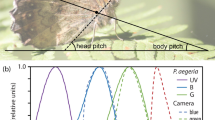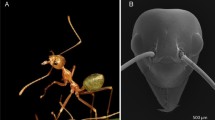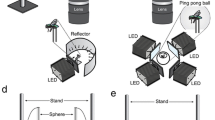Summary
The visual behaviour of the whiteflyTrialeurodes vaporariorum was investigated using a ‘settling’ response paradigm (Fig. 1) and a phototactic paradigm (Fig. 2).
-
1.
Intensity response functions of the ‘settling” response had different shapes at different wavelengths (Fig. 3).
-
2.
Two forms of the ‘settling” response paradigm gave markedly different results (Table 1). This showed that the whiteflies exhibited wavelength specific behaviour.
-
3.
Using the phototactic paradigm, intensity response functions at 400 nm and 550 nm had opposite signs above threshold. There were no colour interaction effects (Figs. 5, 6, 7) and therefore no evidence for colour vision at least for that particular behavioural paradigm.
-
4.
The phototactic paradigm at 400 nm and 550 nm probably measured two different antagonistic behavioural patterns, the visual inputs of which did not interact.
Similar content being viewed by others
References
Autrum H, Thomas I (1973) Comparative physiology of colour vision in animals. In: Jung R (ed) Handbook of sensory physiology, vol VII/3A. Springer, Berlin Heidelberg New York, pp 661–692
Beier W von, Menzel R (1972) Untersuchungen über den Farbensinn der deutschen Wespe (Paravespula germanicaF, Hymenoptera, Vespidae). Zool Jahrb Physiol 76:441–454
Bicker G, Reichert H (1978) Visual learning in a photoreceptor degeneration mutant ofDrosophila melanogaster. J Comp Physiol 127:29–38
Burkhardt D (1964) Colour discrimination in insects. Adv Insect Physiol 2:131–173
Coombe PE (1981) Visual behaviour of the whiteflyTrialeurodes vaporariorum. Ph D thesis, University of Adelaide
Daumer K (1956) Reizmetrische Untersuchungen des Farbensehens der Bienen.Z Vergl Physiol 38:413–478
Fischbach KF (1979) Simultaneous and successive colour contrast expressed in “slow” phototactic behaviour of walkingDrosophila melanogaster. J Comp Physiol 130:161–171
Frisch K von (1914) Der Farbsinn und Formensinn der Biene. Zool Jahrb Physiol 37:1–238
Helversen O von (1972) Zur spektralen Unterschiedsempfindlichkeit der Honigbiene. J Comp Physiol 80:439–472
Hu KG, Stark WS (1977) Specific receptor input into spectral preference inDrosophila. J Comp Physiol 121:253–271
Kiepenheuer J (1968) Farbenunterscheidungsvermögen bei der roten WaldameiseFormicapolyctena. Z Vergl Physiol 57:409–411
Kretz R (1979) A behavioural analysis of colour vision in the antCataglyphis bicolor (Formicidae, Hymenoptera). J Comp Physiol 131:217–233
Kühn A (1927) Über den Farbensinn der Biene. Z Vergl Physiol 5:762–800
Lloyd LL (1922) Notes on the colour tropism ofAsterochiton (Aleurodes) vaporariorum Westwood. Bull Entomol Res 12:355–359
MacDowall FDH (1972) Phototactic action spectrum for whitefly and the question of colour vision. Can Entomol 104:299–307
Mazokhin-Porshnyakov GA (1964) Colour vision in insects — study methods and the present state of our knowledge. Entomol Obozr 43:503–523
Mazokhin-Porshnyakov GA (1969) Insect vision. Plenum Press, New York
Menne D, Spatz HC (1977) Colour vision inDrosophila melanogaster. J Comp Physiol 114:301–312
Menzel R (1975) Colour receptors in insects. In: Horridge GA (ed) The compound eye and vision of insects. Clarendon Press, Oxford, pp 121–153
Menzel R (1979) Spectral sensitivity and colour vision in invertebrates. In: Autrum H (ed), Handbook of sensory physiology, vol VII/6A. Springer, Berlin Heidelberg New York, pp 503–580
Moericke V, Schneiders H, Vogt B (1966) Flughemmung und Fallreflexhaltung als Reaktion auf Gelbreiz beiTrialeurodes vaporariorum (Westwood). Z Pflanzenkr Pflanzenschutz 73:6–14
Naka KI, Rushton WAH (1966) S-potentials from colour units in the retina of fish (Cyprinidae). J Physiol (Lond) 185:536–555
Neumeyer C (1980) Simultaneous colour contrast in the honeybee. J Comp Physiol 139:165–176
Neumeyer C, Heiversen O von (1976) Simultaner Farbkontrast bei der Honigbiene. Verh Dtsch Zool Ges 69:260
Reichert H, Bicker G (1979) A visual learning study of brightness perception in two mutants ofDrosophila melanogaster. J Comp Physiol 133:283–290
Rodieck RW (1973) The vertebrate retina. Freeman, San Francisco
Schümperli RA (1973) Evidence for colour vision inDrosophila melanogaster through spontaneous phototactic choice behaviour. J Comp Physiol 86:77–94
Scopes NEA, Biggerstaff SM (1971) The production, handling and distribution of the whiteflyTrialeurodes vaporariorum and its parasiteEncarsiaformosa for use in biological control programs in glasshouses. Plant Pathol 20:111–116
Swihart CA (1971) Colour discrimination by the butterfly,Heliconius charitonius Linn. Anim Behav 19:156–164
Vaishampayan SM, Kogan M, Waldbauer GP, Woolley JT (1975) Spectral specific responses in the visual behaviour of the greenhouse whitefly,Trialeurodes vaporariorum (Homoptera: Aleyrodidae). Entomol Exp Appl 18:344–356
Vet LEM, Lenteren JC van, Woets J (1980) The parasite-host relationship betweenEncarsiaformosa (Hymenoptera:Aphelinidae) andTrialeurodes vaporariorum. IX. A review of the biological control of the greenhouse whitefly with suggestions for further research. Z Angew Entomol 90:26–51
Author information
Authors and Affiliations
Additional information
Part of a Ph. D. thesis submitted to the University of Adelaide
I thank Professor T.O. Browning for his supervision and interest. I am also indebted to Dr. S. Laughlin who read the manuscript and made valuable comments. The monochromator was kindly provided by the Physics Department, Flinders University, and the thermopile and milli-microvoltmeter by the Physics Department, University of Adelaide.
Rights and permissions
About this article
Cite this article
Coombe, P.E. Wavelength specific behaviour of the whiteflyTrialewodes vaporariorum (Homoptera: Aleyrodidae). J. Comp. Physiol. 144, 83–90 (1981). https://doi.org/10.1007/BF00612801
Accepted:
Issue Date:
DOI: https://doi.org/10.1007/BF00612801




